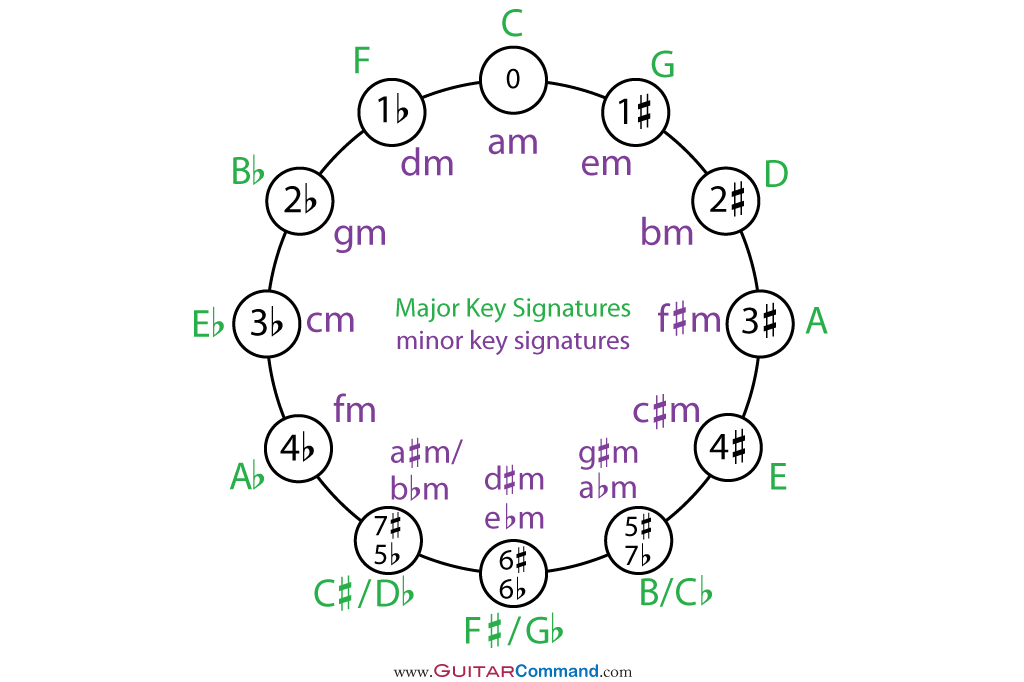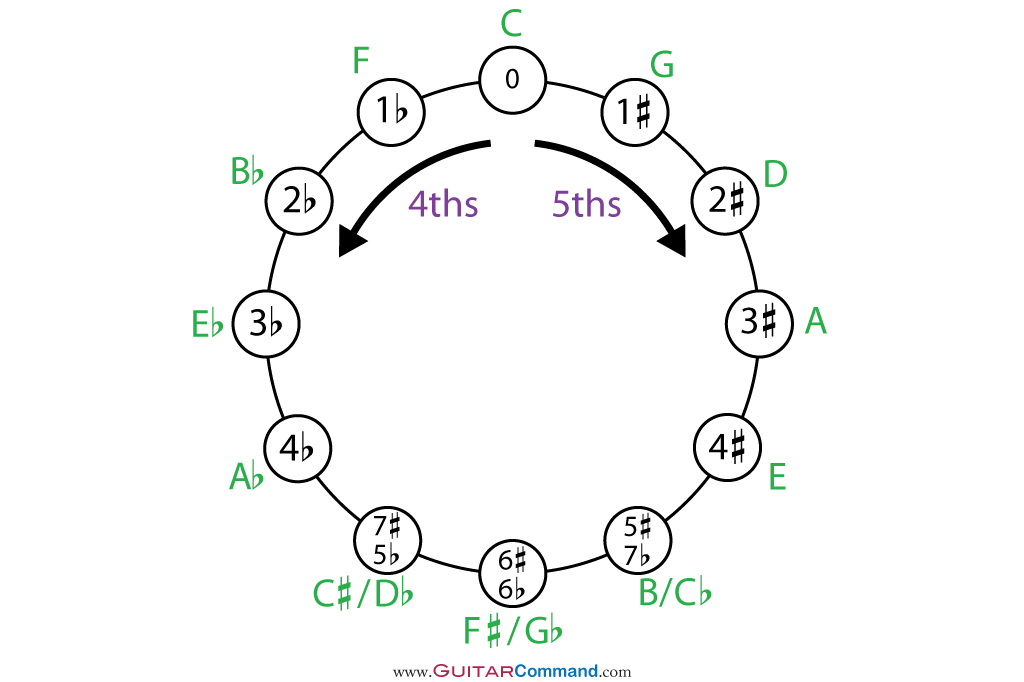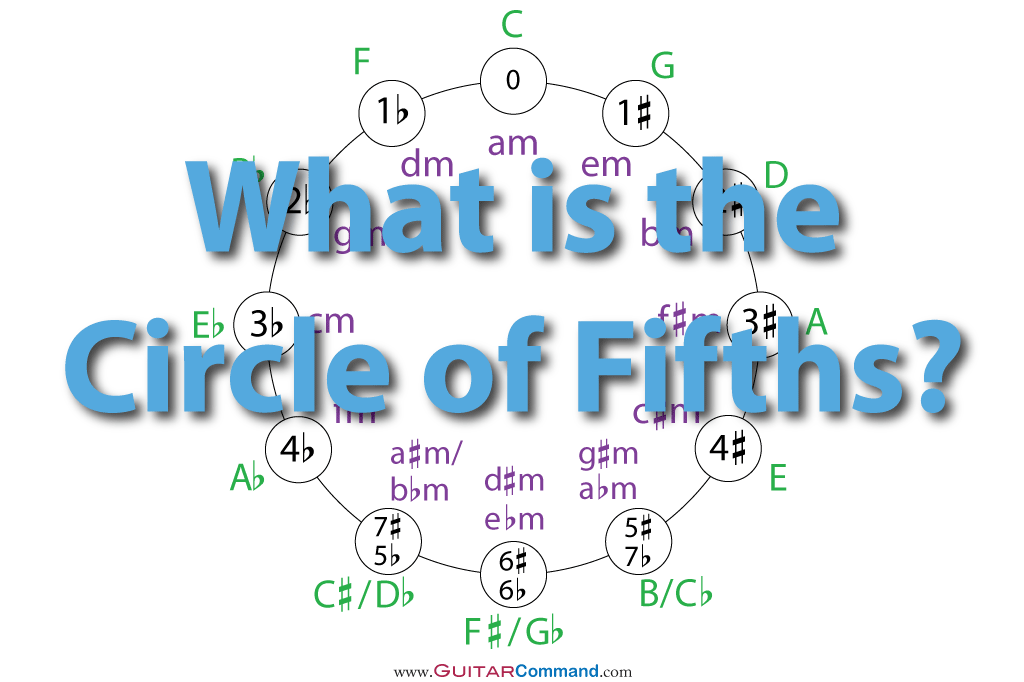What is the circle of fifths? On this page you’ll find a beginner’s guide to this essential concept.
Page Index
- What Is The Circle Of Fifths? A Definition
- The Circle Of Fifths Explained
- Notes In The Chromatic Scale
- Basic Circle Of Fifths Diagram
- The Circle Of Fifths And Key Signatures
- What Is A Key Signature – A Reminder
- The Circle Of Fifths Vs The Circle Of Fourths
- What Is The Circle Of Fifths – Conclusion
What Is The Circle Of Fifths? A Definition
The circle of fifths describes the relationship between the twelve notes of the chromatic scale and their corresponding key signatures.
Each of the 12 notes in the circle of fifths is a perfect fifth higher than the preceding note. The sequence loops around all twelve notes of the chromatic scale before returning to the starting note.
As well as showing the relationship between every note of the chromatic scale and every potential key signature, the circle of fifths can be used as a visual aid for remembering the number of sharps or flats in each key signature.
The circle of fifths can also be used as a composition tool; pieces often move to neighboring key signatures in the circle when they change key.

The Circle Of Fifths Explained
The above definition is quite a mouthful, so for the rest of the page we'll go over what it actually means.
The chromatic scale consists of 12 notes. If you ignore the octave at which the notes are played then the 12 notes of a chromatic scale represent every possible note.
The circle of fifths applies to western music theory; some non-western musical traditions have intervals smaller than a half-tone between notes.
The circle of fifths shows us that a sequence of notes in which each note is a perfect fifth* higher than the previous note will eventually return to the original note – after having been through every note of the chromatic scale.
* A perfect fifth interval is the equivalent of seven half-tones (i.e. seven frets on a guitar).
The sequence is circular, so the above applies with any starting note.
Notes In The Chromatic Scale
Starting on a C, and rising up a half-step between each note, the twelve notes of a chromatic scale are:
- C
- C# / Db*
- D
- D# / Eb*
- E
- F
- F# / Gb*
- G
- G# / Ab*
- A
- A# / Bb*
- B
The pairs of notes marked with an asterisk are what’s known as enharmonic equivalents; they’re the same note with two different names.

The diagram below shows the circle of fifths starting on C. As you can see, all of the notes in the chromatic scale above are included in the circle of fifths.

Basic Circle Of Fifths Diagram

When represented visually, the circle of fifths consists of a circle whose circumference has been divided into 12 parts, just like a clock face.
At each ‘hour’ on the circle of fifths diagram is one of the 12 notes of the chromatic scale.
The note at the twelve-o-clock position is a C. The note at each subsequent position (moving clockwise) is a perfect fifth higher than the previous note.
Therefore the complete sequence of notes is as follows: C, G, D, A, E, B, F# / Gb, C# / Db, G# / Ab, D# / Eb, A# / Bb, F
Moving counter-clockwise, each note is a perfect fourth higher than the previous note. See the 'Circle of Fifths Vs The Circle of Fourths' section, below.
In the circle of fifths, any enharmonic equivalent (i.e. the same note with a different name) of a note is regarded as the same note. Therefore an F# (F sharp) is regarded as being the same as a Gb (G flat).
As you can see from the diagram, a sequence of notes that moves in intervals of a perfect fifth will eventually return to the original note – whatever the starting note. The sequence will contain all twelve notes of the chromatic scale.
In other words, wherever you start on the circle of fifths, after twelve steps (which will contain every possible note) you’ll be back where you started.
The Circle Of Fifths And Key Signatures
Inside the smaller circles in the circle of 5ths diagram are the number of sharps or flats in the corresponding key signature (i.e. C major has 0 sharps or flats, D major has 2 sharps, E flat major has 3 flats, etc.).
The circle of fifths diagram at the top of the page (and repeated below) shows the notes of the chromatic scale and their corresponding key signatures.
We can therefore use the circle of fifths to memorize the number of sharps or flats in every key signature. (See below for an explanation of what a key signature is.)

What Is A Key Signature – A Reminder
A key signature is a group of sharps or flats that appears after the clef in a musical staff. It tells the performer which notes should be sharpened or flattened in the music that follows.

The number of sharps of flats in the key signature indicates the key that the music is in.
In the piece of music above (Twinkle, Twinkle Little Star), there are three sharps in the key signature. Therefore the piece is either in A major or its relative minor, f# minor*. (Note the convention of referring to minor keys using lower case letters.)
Each key signature can be one of either two keys: a major key or its relative minor. The relative minor is always a minor third lower than the major with the same key signature.
* The above piece is clearly in A, not least because the phrase starts and ends on A notes. There are many clues by which you can tell just by looking whether a piece is in a major or minor key, but it is outside the scope of this article to cover this in detail.
The absence of any sharps or flats means that a piece is either in C major or its relative minor, a minor.

The circle of fifths contains all twelve major and all twelve minor keys.
Progressing clockwise around the circle of fifths results in the following keys, as shown below:
- C major / a minor: 0 sharps or flats
- G major / e minor: 1 sharp
- D major / b minor: 2 sharps
- A major / f# minor: 3 sharps
- E major / c# minor: 4 sharps
- B major / g# minor: 5 sharps AND Cb major / ab minor: 7 flats
- F# major / d# minor: 6 sharps AND Gb major / eb minor: 6 flats
- C# major / a# minor: 7 sharps AND Db major / bb minor: 5 flats
- Ab major / f minor: 4 flats
- Eb major / c minor: 3 flats
- Bb major / g minor: 2 flats
- F major / d minor: 1 flat
- C major / a minor: 0 sharps or flats
Moving clockwise around the circle of fifths from the C adds a sharp to each key signature until C# major / a# minor - which have 7 sharps - is reached.
Moving anti-clockwise from the C adds a flat to each key signature until Cb major / ab minor - which have 7 flats - is reached.
Note that some keys have enharmonic equivalents.
The Circle Of Fifths Vs The Circle Of Fourths
Moving counter-clockwise round the circle of fifths results in the circle of fourths. In the circle of fourths, each step represents an interval of a perfect fourth.
Many chord progressions move in 4ths. For this reason some musicians (particularly jazz musicians) prefer to learn the circle of fourths rather than the circle of fifths. Both amount to the same thing, but just seen from a different perspective.
What Is The Circle Of Fifths – Conclusion
- The circle of fifths shows us how notes and key signatures are related.
- Moving in perfect fifths from any start note will result in a sequence of notes that includes every chromatic note before returning to the start note.
- Moving in a clockwise direction from the top of the circle of fifths adds a sharp to each key signature until C# major / a# minor is reached.
- Moving anti-clockwise from the top of the circle of fifths adds a flat to each key signature until Cb major / ab minor is reached.
- Moving anti-clockwise around the circle of fifths results in the circle of fourths.
We hope that you have enjoyed this explanation of the circle of fifths. If you have any questions then feel free to ask away in the comments section below. We’ll be happy to help!
Related Pages
Check out our guide to diatonic chords, where you'll find every available chord in a particular key: Diatonic Chords


